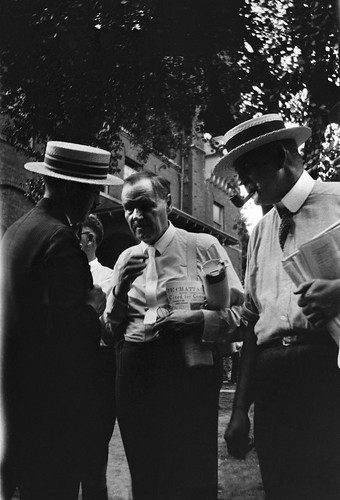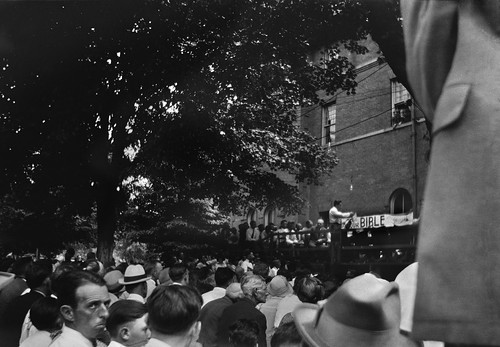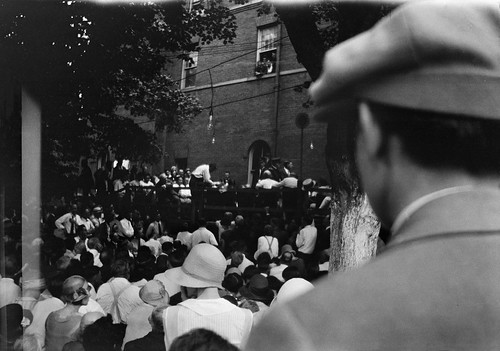This is a follow-up to last week's post about the Smithsonian Institution Archives’ recent acquisition of a series of snapshots from the infamous Tennessee v. John Thomas Scopes trial. During the trial of John Thomas Scopes, professional photographers understandably focused on the celebrities like religious leader William Jennings Bryan and defense attorney Clarence Darrow. Fortunately, a number of capable amateurs also brought cameras to Dayton, Tennessee. The photographs of Watson Davis, for example, led to the identification of previously overlooked participants in the trial. Now, a small set of newly restored photographs, taken by a local college student William Silverman, add other useful perspectives. For historians, three of Silverman’s images hold particular interest.  On Friday, July 17, 1925, Clarence Darrow had insulted the trial judge, John T. Raulston, prompting many observers to assume that the judge would issue a contempt citation. That weekend, local newspapers speculated about the situation and about Darrow’s purpose in provoking the judge. In a photograph taken by William Silverman on Monday, July 20, Darrow stands outside the courthouse, holding a Chattanooga newspaper describing the episode. We can easily imagine that Darrow is discussing strategy with his fellow defense attorney, Arthur Garfield Hays (at right), prior to the morning session. Although the prosecution had blocked all but one of the defense’s expert witnesses from testifying, Judge Raulston had ruled that sworn affidavits could be submitted for the record (to prepare for the inevitable appeal). The jury was sent outside. Hays read the statements to a packed, overheated courtroom. Soon after the lunchtime recess, Darrow apologized for his earlier outburst, the spectators applauded, and the judge made a surprise but welcome announcement. Court would briefly adjourn and reconvene at 1:30 p.m. “down in the yard,” on a temporary platform erected outside to accommodate visiting preachers. Perhaps the shade and a bit of a breeze would cool tempers.
On Friday, July 17, 1925, Clarence Darrow had insulted the trial judge, John T. Raulston, prompting many observers to assume that the judge would issue a contempt citation. That weekend, local newspapers speculated about the situation and about Darrow’s purpose in provoking the judge. In a photograph taken by William Silverman on Monday, July 20, Darrow stands outside the courthouse, holding a Chattanooga newspaper describing the episode. We can easily imagine that Darrow is discussing strategy with his fellow defense attorney, Arthur Garfield Hays (at right), prior to the morning session. Although the prosecution had blocked all but one of the defense’s expert witnesses from testifying, Judge Raulston had ruled that sworn affidavits could be submitted for the record (to prepare for the inevitable appeal). The jury was sent outside. Hays read the statements to a packed, overheated courtroom. Soon after the lunchtime recess, Darrow apologized for his earlier outburst, the spectators applauded, and the judge made a surprise but welcome announcement. Court would briefly adjourn and reconvene at 1:30 p.m. “down in the yard,” on a temporary platform erected outside to accommodate visiting preachers. Perhaps the shade and a bit of a breeze would cool tempers.
 When court resumed (the jury still not present), Hays continued to read the witness statements. Look just behind Hays. Defense attorney Dudley Field Malone (who had steadfastly refused to remove his jacket, despite the oppressive heat) stares out at the crowd. Visible on the courthouse wall is a “Read Your Bible” sign, one of many draped throughout Dayton that month. When Hays finished, the judge sent for the jury—but Darrow rose to make a motion. “Off to the left of where the jury sits,” he said, “is a large sign about ten feet long reading ‘Read Your Bible,’ and a hand pointing to it.” Darrow requested that it be removed. After a lively debate, during which Darrow facetiously suggested an alternative banner urging “Read Your Evolution,” the sign was taken down.
When court resumed (the jury still not present), Hays continued to read the witness statements. Look just behind Hays. Defense attorney Dudley Field Malone (who had steadfastly refused to remove his jacket, despite the oppressive heat) stares out at the crowd. Visible on the courthouse wall is a “Read Your Bible” sign, one of many draped throughout Dayton that month. When Hays finished, the judge sent for the jury—but Darrow rose to make a motion. “Off to the left of where the jury sits,” he said, “is a large sign about ten feet long reading ‘Read Your Bible,’ and a hand pointing to it.” Darrow requested that it be removed. After a lively debate, during which Darrow facetiously suggested an alternative banner urging “Read Your Evolution,” the sign was taken down.
 The defense then executed a dramatic maneuver: they called Bryan to testify as an expert on the King James version of the Bible. And Darrow began one of the most famous examinations in American jurisprudence. Watson Davis’s photographs of that same interrogation had been taken from the back of the platform, directly behind the defense team. His perspective gave a clear view of Bryan’s face and of Darrow’s shoulders hunched forward in attack. We can see many of the defense lawyers leaning forward to listen. On a pole, above Bryan, can be seen a straw hat. In the background, the crowd stretches across the courthouse lawn.
The defense then executed a dramatic maneuver: they called Bryan to testify as an expert on the King James version of the Bible. And Darrow began one of the most famous examinations in American jurisprudence. Watson Davis’s photographs of that same interrogation had been taken from the back of the platform, directly behind the defense team. His perspective gave a clear view of Bryan’s face and of Darrow’s shoulders hunched forward in attack. We can see many of the defense lawyers leaning forward to listen. On a pole, above Bryan, can be seen a straw hat. In the background, the crowd stretches across the courthouse lawn.  William Silverman was standing in the crowd almost diametrically across from Davis. In his photographs, we can see the same pole (at right above the platform) and the shadow of a straw hat. Malone leans on the railing. Next to him is Hays, and then Scopes’s Tennessee attorney John R. Neal. For historians, the trail to understanding such past events most often tracks the texts of documents, and involves close analysis of correspondence, diaries, transcripts, and notes. Perspective comes with time, with re-reading, confirmation, corroboration, and re-confirmation. Photographs, especially in a digital age when professional tools allow alteration, can seem suspect. William Silverman’s images provide another set of valuable confirming perspectives. Recorded from yet another view, they infuse action into the official trial transcript and reveal faces from different angles, famous celebrities and ordinary visitors alike, all captured in the moment, fascinated with the trial. As Robert Lowell admonished in his poem “Epilogue” (1977), our task will be “to give/each figure in the photograph/his living name,” to remember not just where each stood but who they were. Historian Marcel Chotkowski LaFollette is a Research Associate at the Smithsonian Institution and the author of "Reframing Scopes: Journalists, Scientists, and Lost Photographs from the Trial of the Century" (University Press of Kansas, 2008). Marcel wrote about the original set of Watson Davis photographs in an essay for click! photography changes everything.
William Silverman was standing in the crowd almost diametrically across from Davis. In his photographs, we can see the same pole (at right above the platform) and the shadow of a straw hat. Malone leans on the railing. Next to him is Hays, and then Scopes’s Tennessee attorney John R. Neal. For historians, the trail to understanding such past events most often tracks the texts of documents, and involves close analysis of correspondence, diaries, transcripts, and notes. Perspective comes with time, with re-reading, confirmation, corroboration, and re-confirmation. Photographs, especially in a digital age when professional tools allow alteration, can seem suspect. William Silverman’s images provide another set of valuable confirming perspectives. Recorded from yet another view, they infuse action into the official trial transcript and reveal faces from different angles, famous celebrities and ordinary visitors alike, all captured in the moment, fascinated with the trial. As Robert Lowell admonished in his poem “Epilogue” (1977), our task will be “to give/each figure in the photograph/his living name,” to remember not just where each stood but who they were. Historian Marcel Chotkowski LaFollette is a Research Associate at the Smithsonian Institution and the author of "Reframing Scopes: Journalists, Scientists, and Lost Photographs from the Trial of the Century" (University Press of Kansas, 2008). Marcel wrote about the original set of Watson Davis photographs in an essay for click! photography changes everything.
Produced by the Smithsonian Institution Archives. For copyright questions, please see the Terms of Use.

Leave a Comment